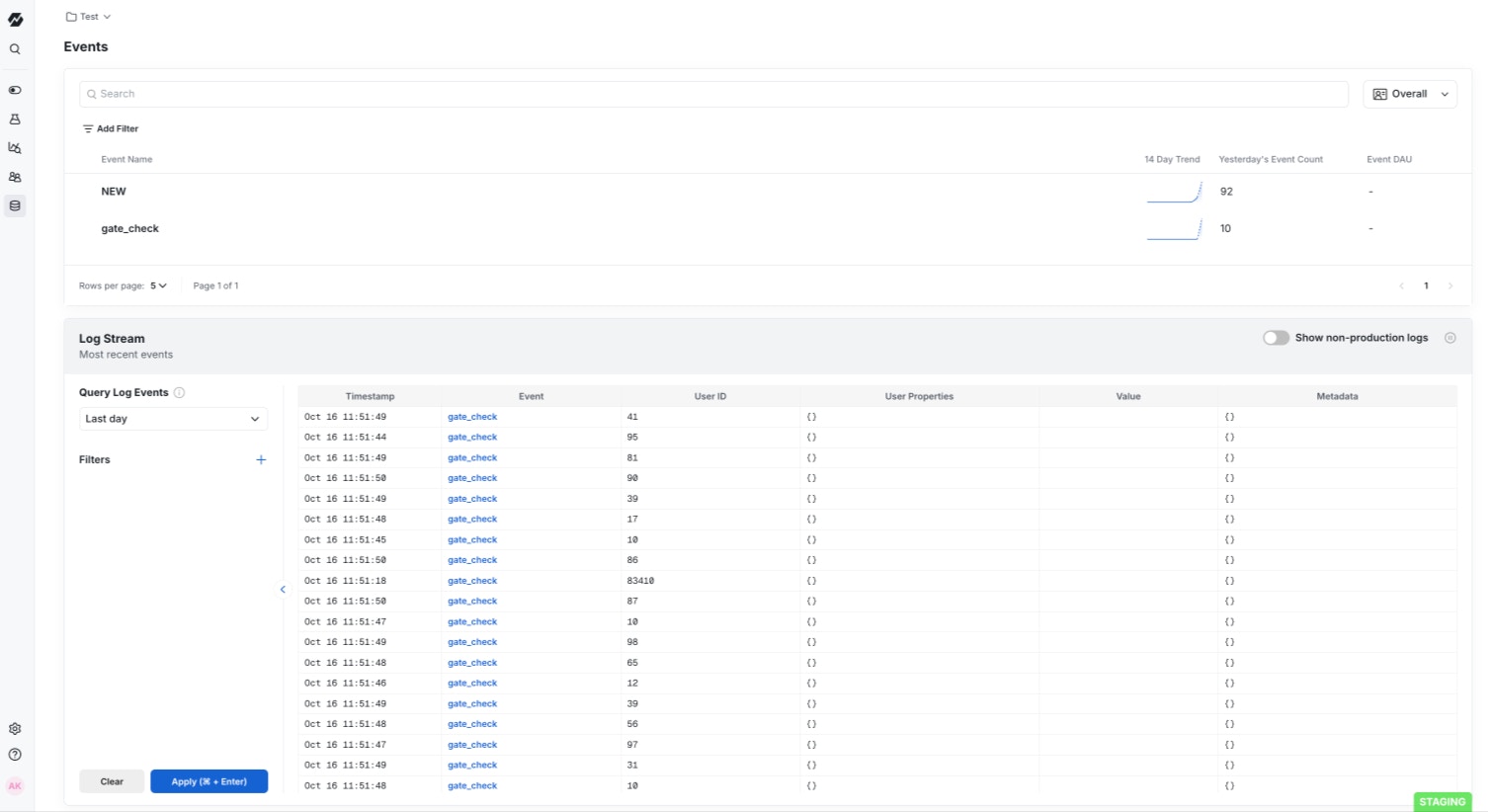- Automatically pushing changes to Cloudflare’s KV store, for low-latency SDK startup
- A helper pattern that handles Statsig SDK overhead, so you can focus on worker logic
1
Configure Integration
Navigate to Project Settings -> Integrations, in the Statsig Console, then select Cloudflare, and input:
- Cloudflare Account ID: Can be found in Cloudflare portal on the Compute (Workers) page, under Account Details
- KV Namespace ID: Create a new namespace, then go to Account Home -> Storage and Databases -> Workers KV, and copy the ID from the table view.
- Cloudflare API Key: In Cloudflare portal under Account Home -> Profile -> API Tokens. Use a token with Account.Workers KV Storage Edit Permissions.
Advanced: Filtering by Target App
Advanced: Filtering by Target App
You can also filter the configs that are synced to your KV namespace by Target App. This becomes important as you add more configs to your project, but for now, you can leave this unchecked.
2
Enable Integration
Click Enable, then the Statsig backend will push a config to your KV namespace (<60 seconds). In your KV namespace, navigate to KV Pairs - you’ll see entry starting with
statsig-. This is the key associated with your KV storage. Note this key down for later.3
Add the Statsig SDK to your Worker
Now, we’ll set up a worker to read those experiments and gates from your KV namespace. If you’ve never created a worker before, you can follow the instructions here.After creating your worker, you will need to connect your KV store to your worker through a binding. Navigate to Compute (Workers) -> Select Your Worker -> Bindings -> Add binding -> KV namespace. Name your binding under Variable name. Under KV namespace, select your KV store name. For more information on connecting your worker to your KV store, you can follow the instructions here.
4
Install the Statsig SDK
Install the Statsig serverless SDK:
5
Use the SDK
The helper method takes two arguments, a handler function, and a ParamsObject. Put all of your worker logic in the handler function, along with your Statsig usage.
Best practice:
The required ParamsObject params (kvKey, envStatsigKey, envKvBindingName) must be stored as env variables, either in your wrangler.toml or as Cloudflare secrets.
ParamsObject Definition
ParamsObject Definition
Environment variable name containing your KV pair key
Environment variable name containing your Statsig client key
Your KV binding name
- store
envStatsigKeyas a Cloudflare secret. You can set this in the Cloudflare dashboard under, Worker → Settings → Variables and Secrets - store
kvKeyandenvKvBindingNamein your wrangler.toml
Example Usage
This is an example of an end-to-end worker function that uses the Statsig SDK and returns a flag value. This is all you need - this will compile as the index.js file in your worker.- Initializes the Statsig Client with config specs from your KV store
- Executes your handler code (Your business logic + Statsig usage)
- Flushes all events after your handler completes execution
- Cleans up resources
Advanced/manual usage
Advanced/manual usage
Use the advanced/manual setup if:Then, you need to hook it all up. This involves:1. Creating a
The client instantiation takes two arguments:The client initialization takes two arguments:This is a gate check in code.The This is an event log in code.The This flushes all events from the sdk to Statsig. Without this, you wont be able to get diagnostic information in the Statsig Console, nor any event data you logged.If you want to check on the evaluations you are getting, you can go to the gate you created for this example and look at the evaluations in the Diagnostics tab.

- You need fine-grained control over initialization timing
- You need fine-grained control over event flushing timing
- You need to customize error handling behavior
Prerequisites
- Completed the Statsig Cloudflare KV integration setup
- Created and bound a KV namespace to your worker
Installation
First, you’ll need to install the Statsig serverless sdk.Import
Next, import the Cloudflare client.- Creating a
StatsigCloudflareClientinstance. - Initializing the Statsig client
- Checking a Gate
- Logging an event
- Flushing events to Statsig
1. Creating a StatsigCloudflareClient instance
sdkKey : stringThis is your Statsig client API key. It is available from the Project Settings page in the Statsig Console. This is used to authenticate your requests.options : StatsigOptionsSee here, for more options.
- store
sdkKeyas a Cloudflare secret. You can set this in the Cloudflare dashboard under, Worker → Settings → Variables and Secrets
2. Client initialization
The following line initializes the client by loading feature gate and experiment configurations directly from your Cloudflare KV store.KvBindingThis is the binding you named earlier. Remember to provide this argument asenv.YOUR_KV_NAMESPACE_BINDINGKvKey : stringThis is the KV pair key that was generated through the Statsig integration. It can be found under Workers KV -> Your KV namespace -> KV Pairs
- store
kvBindingandkvKeyin your wrangler.toml
3. Checking a Gate
checkGate method takes two arguments:name : stringThe name of the Statsig gate that you are checking.user : StatsigUserThe Statsig user object for whom the gate is being checked. For more information on the user object, see here.
4. Logging an event
logEvent method takes two parameters:eventOrName : string | StatsigEventThis is the name and details of the event you are logging.user : StatsigUserThe Statsig user object for whom the event is being logged.
5. Flushing Events
Putting it all together
- index.js
- wrangler.toml



